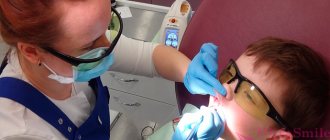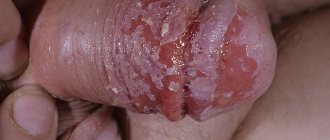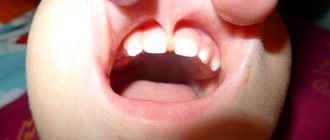Short frenulum of the penis - symptoms
Congenital short frenulum of the penis is accompanied by pain during sexual intercourse, and sometimes ends in rupture.
A rupture (tear) of the frenulum is manifested by severe pain and bleeding.
First aid for a ruptured frenulum is to treat the penis with antiseptics, apply a bandage and apply ice. You should contact a urologist (surgeon) as soon as possible to treat and suturing the wound and stop the bleeding.
A short frenulum of the foreskin is one of the causes of premature ejaculation (link to the page “premature ejaculation”).
The fact is that tension on the frenulum leads to hypersensitivity during friction, and as a consequence, to uncontrolled early ejaculation.
Sometimes a short frenulum of the penis is combined with a narrowing of the foreskin (phimosis), which makes sexual life even more difficult and causes even more inconvenience.
Congenital shortening or insufficient length of the frenulum is a common pathology, detected in 15-20% of men. The cause of this disease has not been established. The problem is sometimes detected in childhood (sometimes in combination with phimosis), but more often it becomes obvious only with the onset of puberty and the first experience of sexual activity.
Diagnosing a short frenulum is not difficult for a urologist. And the patient himself can often suspect this condition based on the characteristic signs mentioned above (pain on the lower side of the glans during sexual intercourse, downward deviation of the head of the penis during erection). If you wish, you can measure the length of the frenulum yourself from the lower surface of the glans to the shaft of the penis. A length of 1.5-2 cm or more is considered normal.
Reasons for the development of tongue frenulum pathology in a child
The formation of an anomaly associated with a short hyoid membrane begins before the birth of the child. This is preceded by negative factors, which include:
- genetic predisposition;
- infection of the fetus during pregnancy;
- viral and infectious diseases suffered by the mother during pregnancy;
- mechanical injuries to the expectant mother’s abdomen;
- the age of the expectant mother is over 35 years;
- unfavorable environmental conditions;
- the influence of other factors of unknown etiology.
Treatment of short frenulum of the penis
The only treatment for short frenulum is surgery. Surgery for a short frenulum (frenuloplasty or frenuloplasty) involves lengthening or excision of this skin fold. There are several options for frenuloplasty.
Classic frenuloplasty
It involves transverse intersection of the frenulum followed by suturing in the longitudinal direction. The advantage of this technique is its simplicity (the operation takes a few minutes).
Among the disadvantages of such plastic surgery, we can note the unevenness along the edges of the incision, formed from the remains of the dissected frenulum. Although the latter can be easily excised and leveled.
Z-plasty
Professor N.D. Akhvlediani proposed Z-shaped plastic surgery with the appropriate incision shape for the correction of premature ejaculation. This method is advantageous in the formation of a more mobile, elastic scar.
Complete excision of the frenulum
In some cases, especially when combined with circumcision, it is better to perform a complete excision of the frenulum, which permanently eliminates this hypersensitive area.
Laser and radio surgery
In recent years, new technologies such as laser or radiosurgery have begun to be used in frenuloplasty. More and more patients are seeking laser frenuloplasty. Indeed, a laser or radiosurgical knife allows frenuloplasty to be performed almost bloodlessly and very aesthetically.
Regardless of the option chosen, frenuloplasty is performed on an outpatient basis under local anesthesia. At the request of the patient, it is possible to perform this operation under anesthesia (during sleep).
For suturing, I use thin self-absorbable threads, which provides excellent cosmetic results and eliminates the need to remove sutures.
After surgery, a circular pressure bandage is usually applied, which protects the wound and reduces the risk of postoperative bleeding.
Wound healing after frenuloplasty takes about 10 days. Dressings are usually performed by the patient independently.
Restrictions after surgery relate only to sexual abstinence during the period of wound healing. There is no need to take sick leave or give up sports.
Phimosis - symptoms and treatment
Non-drug treatment
Physiological phimosis can be eliminated without surgical treatment . [4] The most acceptable method is gradual gentle stretching of the foreskin. Treatment of phimosis in children can be carried out starting from six months.
The elimination of phimosis using a bloodless method based on two principles.[7]
The first principle is a slow impact on the narrowed cavity of the foreskin. Treatment is carried out in stages and can last from 3-5 months to several years. During such events, the head of the penis ideally opens by the beginning of puberty, i.e. by 12-15 years. These dates are due to hormonal changes in the boy’s body.
The second principle is the most gentle stretching of the foreskin, in which even minimal injuries (tears, cracks) of the narrowed area are unacceptable. Each procedure is designed to dynamically open the foreskin cavity by 1-2 mm from the initial state. In order to improve the stretching of the flesh, before the procedure the patient should lie for 10-15 minutes in a bath with decoctions of chamomile, string, celandine or calendula. Thanks to this, the skin is steamed, stretches easier and is less injured. After the bath, stretching manipulations should be performed for at least 15 minutes. Then the foreskin should be treated with baby cream, levomekol, ELMA ointment 5% or solcoseryl - they help heal any microtears that arise. At the end of the procedure, the child should lie on his back for several minutes without diapers or underwear.
Initially, these procedures are performed by a doctor, who is obliged to show the technique of such manipulations to the parents. In the future, treatment comes down to the parents' daily compliance with the doctor's recommendations and medical monitoring of the dynamics of the process of displacement of the foreskin once every 3-6 months.
These principles are a very effective way to treat physiological phimosis. Thanks to them, the head of the penis opens halfway after 2-3 months in 91% of cases. In general, the success of treatment using this method depends on how regularly the procedures are carried out.
Also, in the treatment of phimosis, rings and bandages , which stretch the foreskin and fix its shape.[10]
Drug therapy
This treatment method involves regular and long-term use of corticosteroid ointments. They are applied to the foreskin and glans penis to increase the elasticity of the tissue and improve its stretchability.
Also, for phimosis, taking glucocorticoids is indicated. They are designed to reduce swelling and inflammation, accelerate the healing of microcracks, and suppress the activity of connective tissue formation.
The most effective ointments to combat phimosis are clobetasol 0.05%, betamethasone 0.05%, prednitop 0.25%, gel 2.5%.
Physiotherapy
Physiotherapeutic treatment methods include:[11]
- Phonophoresis is a painless injection of drugs into the deep layers of the skin using ultrasound. In case of phimosis, anandrogen-containing oil preparations are applied to the external opening of the foreskin. The exposure is carried out using a labile technique with a radiation frequency of 880 Hz, a working surface of 0.5 cm2, an intensity of 0.4 W/cm2 and a continuous mode of ultrasonic vibrations. The duration of the procedure is six minutes. They are carried out every other day for 1-2 weeks. This method provides effective treatment of the disease.
- Using a button probe to gradually gently stretch the foreskin. It is used in conjunction with 2.5% dihydrotestosterone gel and allows you to separate synechiae. This procedure is carried out twice a week after hygienic baths with decoctions of medicinal herbs.
Surgical treatment
Circular excision of the foreskin is indicated in cases of cicatricial phimosis. In this case, the foreskin can be removed partially (excision along the border of fibrous changes) or completely - partial or complete circumcision. In children it is performed under general anesthesia, and in adults under local anesthesia.[6] Complications after circumcision are rare. Sometimes bruising occurs on the penis, but this goes away over time.[12]
Other methods of foreskin plastic surgery:
- Prepucioplasty is performed for phimosis in adolescents with minor cicatricial changes in the skin fold. During the operation, a longitudinal incision is made along the upper part of the penis and adhesions are removed, then the wound is sutured.
- Surgical treatment with clamps is performed in children. Use Mogen clamps or disposable Plastibel clamps. Disposable clamps are placed on the head of the penis after a small incision, fixed and left for a week. No stitches are needed. The Mogen clamp is applied for 1-5 minutes and removed after cutting off the skin.
Laser treatment of phimosis
This method of treating phimosis is called the photodestructive method. Using a laser, the doctor excises and removes the abnormal tissue. The beam aimed at the flesh has a temperature of up to 300 ℃. Once on the fabric, it evaporates, or vaporizes.
The operation lasts approximately 20 minutes, including the procedure itself, preparation of documents and discharge. The laser beam quickly seals the vessels, without damaging the tissues and preventing blood loss.
Treatment of phimosis with traditional methods
The effectiveness and safety of traditional methods has not been scientifically proven. Phimosis often goes away on its own with age, which reinforces misconceptions about the effectiveness of alternative medicine.
Rehabilitation
After the operation you will need:
- Maintaining cleanliness - proper care will help avoid inflammation and suppuration. The treatment site can be treated with antiseptics: chlorhexidine and miramistin. Baths with potassium salt of permanganic acid are also useful.
- Monitoring by the attending physician - if inflammation, suppuration and pain occur, you should consult a doctor.
- Rest - during the first 2-3 days, it is advisable to lie down more often, as this increases the outflow of blood from the penis and reduces the development of tissue edema.
- Strict adherence to the dressing schedule established by the attending physician. After circumcision, bandages are applied to the penis, which are worn all the time until the penis heals, and are changed periodically. To wash the penis with warm and soapy water, the first change of bandages is carried out after 48 hours.
- Local treatment with antibacterial ointments. To avoid suppuration, your doctor may recommend using antibacterial ointments, such as Levomekol and Levomethyl.
- It is important to ensure that the child does not touch the wounds with his hands. Instead of water procedures, it is better for the boy to be rubbed down until complete healing.
- It is not recommended to wash the penis for 7 days until the stitches are removed. To avoid getting the wound wet while showering, you should wear a condom on the penis. It is also important to ensure that urine does not come into contact with the wound, otherwise inflammation may develop and the wound will heal more slowly.
- Comfortable underwear. If the foreskin is removed on a small child, then the best option would be thick panties so that he does not touch his penis during play. An adult man should wear loose underwear that does not restrict movement.
- Until complete healing, abstinence from sexual activity will be required.
Complications after frenuloplasty
Like any other operation, frenuloplasty can be complicated by wound inflammation, bleeding and the formation of a rough scar.
Infectious and inflammatory complications can develop both as a result of violation of the rules of asepsis during surgery, and due to improper treatment of the wound in the postoperative period and during dressings. Prevention of this type of complications is strict adherence to hygienic requirements during and after surgery.
Bleeding may occur in the first day or two after surgery and is sometimes quite profuse. The cause may be insufficiently reliable suturing of the vessels during surgery or a violation of the blood coagulation system. To prevent bleeding, it is necessary to perform thorough hemostasis with control of all vessels, as well as a mandatory preoperative study of the coagulation system (coagulogram).
The formation of a rough scar after frenuloplasty is an unpleasant problem from both a cosmetic and functional point of view. A rough scar in the frenulum area can be a source of hypersensitivity and premature uncontrolled ejaculation.
The use of modern technologies, such as laser and radiosurgical knife, as well as careful treatment of tissues and the use of modern suture material, allow us to avoid this problem.
From my own experience, I can say that over the past ten years I have not had a single complication after frenuloplasty.
How to check if a child has a short frenulum
The presence of difficulties with the frenulum can be easily determined independently:
- Open your mouth slightly and place the tip of your tongue in the area behind your upper teeth. In this position, the place of attachment of the frenulum is clearly visible. If it is not “where it needs to be,” it is difficult to lift the tongue up.
- Pull your tongue forward. A short frenulum does not allow this to be done; in addition, the tip of the tongue visually looks forked
- Open your mouth and try to touch your upper lip with your tongue and lick it. Difficulties with the bridle make this movement difficult to perform.
Please note: sometimes a child cannot cope with these exercises not because there is something wrong with the frenulum. The cause may be weak muscles of the articulatory apparatus. Take a clean handkerchief and try to help your tongue. If resistance is felt when moving, then the problem is still in the hyoid frenulum.
In what cases should you contact a urologist for consultation?
So, in what cases should you contact a urologist for consultation on plastic surgery of the frenulum of the penis?
- with a short frenulum
- with previous tears and microcracks of the frenulum
- when the head of the penis is deviated downwards
- with premature ejaculation
Why is it important not to delay surgery for a short frenulum of the penis?
- A timely operation prevents complications such as rupture or tearing of the frenulum, accompanied by quite severe bleeding
- Frenumplasty relieves pain and discomfort during erection and sexual intercourse
- Eliminating this problem in some cases restores the normal duration of sexual intercourse
You can familiarize yourself with contraindications for frenuloplasty, as well as the list of necessary examinations, on the “Preparation for planned operations” page.
I will be glad to help you solve this delicate problem and offer any of the frenuloplasty options, performed by experts at a competitive price.
Pay attention to the promotion - frenuloplasty as a gift (Learn more...) when denervation of the head is performed in combination with circumcision. An ideal option to actually increase the duration of sexual intercourse!
Author: candidate of medical sciences, doctor of the highest category, Rotov Anton Evgenievich
Functions of the foreskin
The foreskin performs important functions. Among them:
- protection from external influences (this includes dirt, infections, mechanical irritation);
- moisturizing the sensitive head of the penis, keeping it moist, warm, soft;
- immunological protection due to the glands of the foreskin, which secretes antibacterial and antiviral proteins;
- gives an additional pleasant sensation from sexual contact when stretched, since the prepuce is rich in many nerve endings.
The presence of foreskin in a man is a protection given by nature and an increase in erotic sensations. It is highly undesirable to remove it by cutting. Therefore, the flesh should be kept healthy. At the first adverse symptoms, consult a doctor.
Symptoms and diseases of the foreskin:
- Swelling of the foreskin
- Foreskin rupture
- Inflammation of the foreskin
- Redness of the foreskin
- Foreskin removal
- Narrowing of the foreskin
- Ulcers on the foreskin
- Herpes on the foreskin
- Red spots on the foreskin
- Sores on the foreskin
- Dryness of the foreskin
Questions about the article
Peter 20 years old
July 28, 2022 at 00:00
Doctor, hello. We performed a frenuloplasty operation, the operation was bloodless, the doctor did not use a scalpel. On the third day, sex occurred at night. In the morning I noticed very small specks of dried blood on the wound. Please tell me, is this dangerous? Could it be fraught with the formation of a rough scar or any other complications?
drrotov
July 29, 2022 at 15:30
No, I don't think it's dangerous. This area is healing well.
Ivan 21 years old
April 15, 2022 at 00:00
Hello. I had a quadruple operation at once: straightening the inverter (there was a downward tilt), lengthening the frenulum, complete circumcision and ligamentotomy.
drrotov
April 16, 2022 at 12:00
Great! You forgot to ask a question...
In what cases is it necessary to trim the bridle?
The operation of cutting the frenulum of the tongue is called frenulotomy . It is classified as simple and requires only local anesthesia.
Heavy bleeding during frenulotomy is very rare; after a couple of hours the child will be able to return to the usual rhythm of life.
If a short frenulum interferes with the newborn baby's ability to receive nutrition, it must be trimmed. The decision about surgery is made by a pediatric neonatologist.
For infants, as a rule, the operation is performed without anesthesia, since only the sublingual film of connective tissue is dissected, which has practically no blood vessels or nerve endings.
For children aged 3-5 years, surgery to cut the frenulum is performed under local anesthesia. The dentist decides whether surgery is necessary, and the speech therapist prescribes the referral.
Before the operation, the child needs to donate blood for a detailed analysis, which will display numerous indicators, including the number of platelets and the rate of blood clotting.
Surgical intervention is performed provided that the pathology is moderate or severe with limited tongue mobility. After surgery, speech therapy sessions are necessary.
There are a number of indications for frenulotomy, and limited tongue mobility is not the only one. The formation of malocclusion in a child, displacement and disturbances in the formation of the dentition, low effectiveness of speech therapy and articulation gymnastics, as well as the need to install dental implants or orthodontic structures for the child.
Pathology of the tongue frenulum does not always require surgical intervention. If the child does not experience any discomfort during breastfeeding, and his pronunciation of sounds is satisfactory, then it is likely that a speech therapist will help solve the problem. In this case, the child attends special classes, performs speech therapy exercises, articulation gymnastics, etc.











